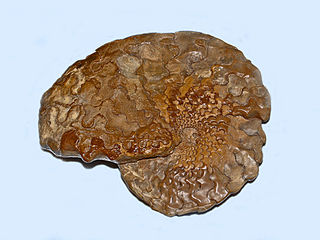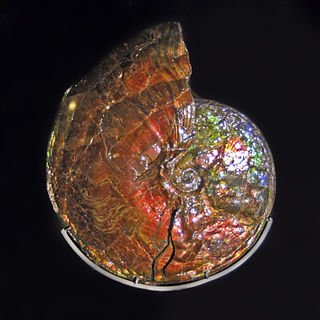
Ammonoids are extinct spiral shelled cephalopods comprising the subclass Ammonoidea. They are more closely related to living coleoids than they are to shelled nautiloids. The earliest ammonoids appeared during the Devonian, with the last species vanishing during or soon after the Cretaceous–Paleogene extinction event. They are often called ammonites, which is most frequently used for members of the order Ammonitida, the only remaining group of ammonoids from the Jurassic up until their extinction.

Goniatids, informally goniatites, are ammonoid cephalopods that form the order Goniatitida, derived from the more primitive Agoniatitida during the Middle Devonian some 390 million years ago. Goniatites (goniatitids) survived the Late Devonian extinction to flourish during the Carboniferous and Permian only to become extinct at the end of the Permian some 139 million years later.
Frechites is an early Triassic ammonite, a kind of cephalopod with an external shell, included in the ceratitid family Beyrichitidae.
Ussuria is a genus of Lower Triassic ammonites with a smooth, involute discoidal shell with submonophyllic sutures, belonging to the ceratitid family Ussuriidae.

Ceratitida is an order that contains almost all ammonoid cephalopod genera from the Triassic as well as ancestral forms from the Upper Permian, the exception being the phylloceratids which gave rise to the great diversity of post-Triassic ammonites.
Noritoidea, formerly Noritaceae, is an extinct superfamily of cephalopods belonging to the Ammonite order Ceratitida.

Lytoceratina is a suborder of Jurassic and Cretaceous ammonites that produced loosely coiled, evolute and gyroconic shells in which the sutural element are said to have complex moss-like endings.
Thalassoceratidae a family of late Paleozoic ammonites included in the goniatitid superfamily Thalassoceratoidea along with the Bisatoceratidae. Some eight genera are included, although the specific number and exactly which depends on the particular classification.

Ammonitina comprises a diverse suborder of ammonite cephalopods that lived during the Jurassic and Cretaceous periods of the Mesozoic Era. They are excellent index fossils, and it is often possible to link the rock layer in which they are found to specific geological time periods.

Placenticeras is a genus of ammonites from the Late Cretaceous. Its fossils have been found in Asia, Europe, North and South America.
The Clydonautiloidea are a superfamily within the nautiloid order Nautilida characterized by smooth, generally globular, shells with nearly straight sutures, in early forms, but developing highly differentiated sutures in some later forms. Where known, the siphuncle tends to be central to subcentral.

Grypoceratidae is the longest-lived family of the Trigonoceratoidea, or of the near equivalent Centroceratina; members of the Nautilida from the Upper Paleozoic and Triassic.

Tissotiidae is a family of ammonites (Ammonitina) belonging to the Acanthoceratoidea.

Tetragonitidae is a family of Cretaceous lytoceratin ammonites typically with square or trapezoidal whorl section at least during some growth stage. Members of this family are usually smooth but some lirate or striate, often with constrictions. Other features include suture with a varying number of auxiliary saddles, and an internal suture with two or more. Major saddles are irregularly trifid. The family is derived from the genus Tetragonites.
Cravevoceras is an Upper Paleozoic ammonite in the goniatite family Cravenoceratidae, probably derived from Pachylyroceras and contemporary with other cravenoceratid genera like Caenolyroceras, Tympanoceras and later Alaoceras and Lyrogoniatites. It is also a member of the Neoglyphioceratoidea.

Engonoceratidae is a family of typically compressed, more or less flat sided and involute ammonites from the mid Cretaceous belonging to the Hoplitoidea. shells have flat sided outer rims ( venters), at least in some stage. Single or branching irregular ribs and variably placed tubercles may occur. Sutures have numerous auxiliary and adventive elements of similar form, in general radially arranged. Forwardly divergent saddles tend to be simple, without subdivision. Lobes, pointing apically, may be simple and undivided or may be frilled with short irregular serrations.

Placenticeratidae is an extinct family of mostly Late Cretaceous ammonites included in the superfamily Hoplitoidea, derived from the Engonoceratidae by an increase in suture complexity.
Bochianites is a straight shelled ammonite which lived from the Upper Jurassic, Tithonian, to the Lower Cretaceous, Hauterivian in what is now Europe, Greenland, Africa, North America and Asia. The shell is long, narrow, moderately expanding; smooth or with weak to strong oblique annular ribs. Sutural elements are short and boxy. The umbilical lobe, which lies between the lateral lobe and dorsal lobe, on either side, is about the same size as the lobule dividing the first lateral saddle.
The Meekoceratidae is a family of ceratitid ammonites described in the Treatise on Invertebrate Paleontology, as being more or less involute, compressed, discoidal, smooth to weakly ornamented; venter arched or tabulate; sutures ceratitic with broad saddles. Now includes four subfamilies.
Flickiidae is a family of dwarf ammonites with little ornament and very simples sutures known from small pyritic specimens found in middle Cretaceous deposits. Inclusion in the Acanthoceratoidea is tentative.











